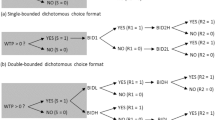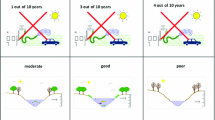Abstract
Modeling households' behavior with the data from a contingentvaluation (CV) survey is often complicated by samplenon-response, which can cause non-response bias and sampleselection bias, leading to inconsistent parameter estimates and adistorted mean willingness-to-pay estimate. This paper reportsthe results of empirical tests for both biases using householdsurvey data in which the double-bounded dichotomous choice CVquestion involved the benefit of a tap water quality improvementpolicy in Korea. No non-response bias, but sample selection bias,is detected in the sample. To correct for sample selection bias,a sample selection model is employed. The authors also discusshow failure to correct for bias may distort aggregate benefitestimates.
Similar content being viewed by others
REFERENCES
Alberini, A. (1995), ‘Efficiency vs Bias ofWillingness-to-Pay Estimates: Bivariate and Interval-Data Models’, Journal of Environmental Economics and Management 29, 169–180.
Amemiya, T. (1984), ‘Tobit Models: A Survey’, Journal of Econometrics 24, 3–61.
Arrow, K., R. Solow, P. R. Portney, E. E. Leamer, R. Radner and H. Schuman (1993), ‘Report of the NOAA Panel on Contingent Valuation’, Federal Register 58, 4601–4614.
Bateman, I. J. and I. H. Langford (1997), ‘Budget-Constraint, Temporal, and Question-Ordering Effects in Contingent Valuation Studies’, Environment and Planning A 29, 1215–1228.
Bateman, I. J., I. H. Langford, A. P. Jones and G. N. Kerr (2001), ‘Bound and Path Effects in Double and Triple Bounded Dichotomous Choice Contingent Valuation’, Resource and Energy Economics, in press.
Cameron, T. A. and D. James (1987), ‘Efficient Estimation Methods for “Closed-Ended” Contingent Valuation Surveys’, Review of Economics and Statistics 69, 269–276.
Cameron, T. A. and J. Quiggin (1994), ‘Estimation Using Contingent Valuation Data from a “Dichotomous Choice with Follow-up” Questionnaire’, Journal of Environmental Economics and Management 27, 218–234.
Carson, R. T., T. Groves and M. J. Machina (1999), ‘Incentive and Informational Properties of Preference Questions’, Plenary Address, Ninth Annual Conference of the European Association of Environmental and Resource Economists (EAERE). Oslo, Norway, June.
Cooper, J. and W.M. Hanemann (1995), ‘Referendum Contingent Valuation: HowMany Bounds Are Enough?’, USDA Economic Research Search Service, Food and Consumer Economics Division, working paper, May.
Dubin, J. A. and D. Rivers (1989), ‘Selection Bias in Linear Regression, Logit and Probit Models’, Sociological Methods and Research 18, 360–390.
Edward, F. E. and G. D. Anderson (1987), ‘Overlooked Biases in Contingent Valuation Surveys: Some Considerations’, Land Economics 63, 168–178.
Eklöf, J. and S. Karlsson (1997), ‘Testing and Correcting for Sample Selection Bias in Discrete Choice Contingent Valuation Studies’,Working Paper No. 171. Stockholm School of Economics, Sweden.
Hanemann, W. M. (1984), ‘Welfare Evaluations in Contingent Valuation Experiments with Discrete Responses’, American Journal of Agricultural Economics 66, 332–341.
Hanemann, W. M. and B. J. Kanninen (1999), ‘The Statistical Analysis of Discrete-Response CV Data’, in I. J. Bateman and K. E. Willis, eds., Valuing Environmental Preferences: Theory and Practice of the Contingent Valuation Method in the US, EU, and Developing Countries. Oxford: Oxford University Press.
Hanemann, W. M., J. B. Loomis, and B. J. Kaninnen (1991), ‘Statistical Efficiency of Double-Bounded Dichotomous Choice Contingent Valuation’, American Journal of Agricultural Economics 73, 1255–1263.
Hausman, J. A., ed. (1993), Contingent Valuation: A Critical Assessment. Amsterdam: North-Holland.
Heckman, J. J. (1979), ‘Sample Selection Bias as a Specification Error’, Econometrica 47, 153–161.
Kwak, S. J. and C. S. Russell (1994), ‘Contingent Valuation in Korean Environmental Planning: A Pilot Application to the Protection of Drinking Water Quality’, Environmental and Resource Economics 4, 511–526.
Loomis, J. B. (1987), ‘Expanding Contingent Value Sample Estimates to Aggregate Benefit Estimates: Current Practice and Proposed Solutions’, Land Economics 63, 396–402.
Langford, I. H., I. J. Bateman and H. D. Langford (1996), ‘A Multilevel Modelling Approach to Triple-Bounded Dichotomous Choice Contingent Valuation’, Environmental and Resource Economics 7, 197–211.
Mattsson, L. and C. Z. Li (1994), ‘Sample Nonresponse in a Mail CV Survey: An Empirical Test of the Effect on Value Inference’, Journal of Leisure Science 26, 182–188.
McConnell, K. E. (1990), ‘Models for Referendum Data: The Structure of Discrete Choice Models for Contingent Valuation’, Journal of Environmental Economics and Management 18, 19–34.
McFadden, D. (1994), ‘Contingent Valuation and Social Choice’, American Journal of Agricultural Economics 76, 689–708.
Mitchell, R. C. and R. T. Carson (1989), Using Surveys to Value Public Goods: The Contingent Valuation Method. Washington, D.C.: Resources for the Future.
Schuman, H. (1996), ‘The Sensitivity of CV Outcomes to CV Survey Methods’, in D. J. Bjornstad and J. R. Kahn, eds., The Contingent Valuation of Environmental Resources. Cheltenham, U.K.: Edward Elgar.
Vella, F. (1992), ‘Simple Tests for Sample Selection Bias in Censored and Discrete Choice Models’, Journal of Applied Econometrics 7, 413–421.
Whitehead, J. C. (1994), ‘Item Nonresponse in Contingent Valuation: Should CV Researchers Impute Values for Missing Independent Variables?’, Journal of Leisure Science 26, 296–303.
Whitehead, J. C., P. A. Groothuis and G. C. Blomquist (1993), ‘Testing for Non-Response and Sample Selection Bias in Contingent Valuation: Analysis of a Combination Phone/Mail Survey’, Economics Letters 41, 215–220.
Whitehead, J. C., P. A. Groothuis, T. J. Hoban and W. B. Clifford (1994), ‘Sample Bias in Contingent Valuation: A Comparison of the Correction Methods’, Leisure Science 16, 249–258.
Willig, R. D. (1976), ‘Consumer Surplus without Apology’, American Economic Review 66, 587–597.
Yoo, S.-H., S.-J. Kwak and T.-Y. Kim (2001), ‘Modeling Willingness to Pay Responses from Dichotomous Choice Contingent Valuation Surveys with Zero Observations’, Applied Economics 33, 523–529.
Author information
Authors and Affiliations
Rights and permissions
About this article
Cite this article
Yoo, SH., Yang, HJ. Application of Sample Selection Model to Double-Bounded Dichotomous Choice Contingent Valuation Studies. Environmental and Resource Economics 20, 147–163 (2001). https://doi.org/10.1023/A:1012625929384
Issue Date:
DOI: https://doi.org/10.1023/A:1012625929384




